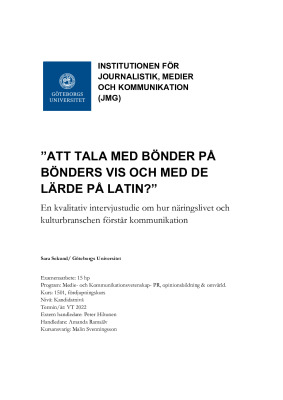ATT TALA MED BÖNDER PÅ BÖNDERS VIS OCH MED DE LÄRDE PÅ LATIN?
En kvalitativ intervjustudie om hur näringslivet och kulturbranschen förstår kommunikation
Executive Summary
Unlike the business industries, which thrive upon economic purposes, cultural arts industries are often described being artistic and complex. In Sweden, good communication between business and cultural arts has been recognized as necessary for both parties to succeed in society. However, the
relationship is often associated with conflicting interests, lack of knowledge, and difficulties linked to communication and language.
The aim of this thesis was twofold. First, the purpose was to investigate how the cultural- and business industries understand communication. Second, the objective was to analyze the possible consequences of this understanding. The main research question was: How do representatives from the cultural and business industries describe the concept of communication? Furthermore, how can the communicative difficulties between them be understood?
This thesis collaborates with the organization Kulturakademin, a regional resource for competence development in arts, crafts, performing arts, music, and audiovisual media in Västra Götaland, Sweden. The method used was qualitative interviews. Four actors represent the business area, and
five represent the cultural and creative area. Furthermore, the implementation of Pierre Bourdieu’s Social Fields Theory and a Scandinavian Neoinstitutional perspective has served as a framework applied to the empirical analysis.
Through analysis of literature, application of theories, dialogue with the organization Kulturakademin and interviews with actors in large to medium-sized companies in business and cultural arts industries, the findings imply that both business and cultural arts understand communication in a relatively similar way. However, some aspects significantly distinguish them.
The business industry sees communication as transmission, while the cultural arts industry sees communication as a conversation. Communication seems to be an unreflected activity, influenced by organizational norms and perceptions. In addition, the results from both business and the cultural industry show that communication is inconstant and adaptable, which can be explained by both dependence on norms and perceptions and a kind of imbalance of power and dependency between them. The results also show that their respective social fields limit the business and cultural industries and that they have different views on how one should relate to the outside world.
This study also examined possibilities for mutual understanding and proposes actions for Kulturakademin in the future. The challenges lie in mutual understanding beyond values, cognitive perceptions, and prejudice. To overcome difficulties linked to communication, the two parties must
reach a shared understanding and respect for each other.

